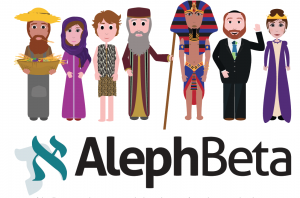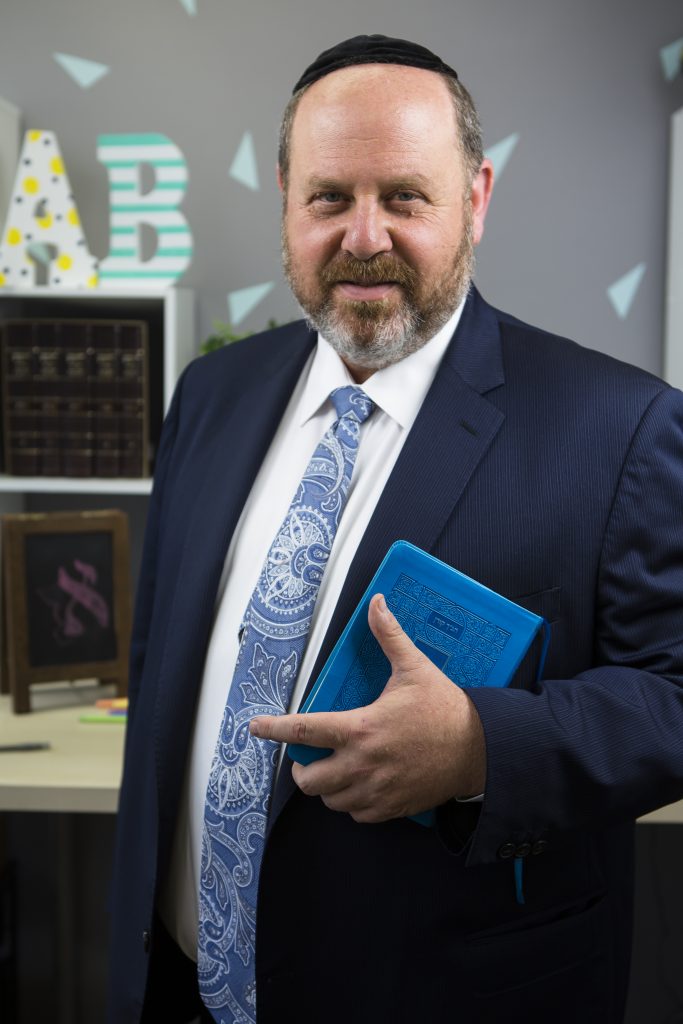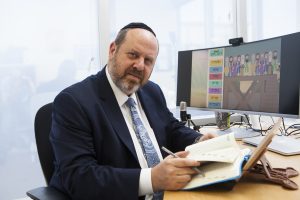Up Close with Rabbi David Fohrman
NCSY Director of Education Rabbi Dovid Bashevkin speaks with one of the most innovative and dynamic personalities in the world of Tanach study. An internationally renowned lecturer on Biblical themes and the principal educator at Aleph Beta—an initiative to bring Torah to life through engaging videos—Rabbi David Fohrman has served as an adjunct professor at Johns Hopkins University, and as a lead writer and editor for ArtScroll’s Talmud translation project. Rabbi Fohrman has also served as scholar for the Hoffberger Foundation for Torah Study for ten years. Rabbi Fohrman spent his childhood years in the San Francisco Bay Area and currently lives in Woodmere, New York, with his wife and children.
Rabbi Dovid Bashevkin: Can you describe your approach to Tanach?
Rabbi David Fohrman: Contemporary Biblical commentary comes in three different varieties, and while my approach doesn’t fit neatly into any of them, it does include elements of all three.
The first type of Biblical commentary is “critical academic scholarship.” My approach wouldn’t be considered academic for two reasons. First, I write for a lay audience as much as for a scholarly one. Second, I seek to explore how we’re meant to relate to these texts, how they should inform our lives, and what spiritual meaning the Torah wants us to derive from them. Academic writing is typically silent on those questions.
At the other end of the spectrum lies English-language commentary that focuses more directly on questions related to inspiration and meaning. That kind of Biblical commentary tends to offer nuggets of inspiration for the benefit of the reader but does not rigorously examine the Biblical text.
Finally, a third kind of Biblical analysis is the anthology—such as the ArtScroll methodology—where the thoughts of various commentators are presented, but the reader generally does not attempt to grapple with the text himself.
None of these approaches fully describes my methodology. I would explain my approach as an attempt to understand the depth of peshat by looking carefully at the text in concert with Chazal. I try to engage with the Hebrew text of the Torah—everything else revolves around that. I draw on commentary, principally Midrashic commentary, not as much on commentary from the Rishonim. And I also explore the spiritual meaning; however, my approach allows the meaning to arise organically from a close examination of the text.
RDB: How would you respond to those who might criticize you and say, “Why don’t you just build off the edifices that have already been constructed by Rashi, the Ramban, the Seforno and all the other Rishonim in the standard Mikraot Gedolot?”
RDF: We have conditioned ourselves to believe that to learn b’iyun (in-depth) means to read what commentators have said. But I don’t think that’s true. I don’t think it’s true regarding Gemara and I don’t think it’s true regarding Chumash.
When it comes to Chumash, we are not used to thinking deeply about the language of the text itself. Imagine if a young yeshivah student said, “I’m not going to try to learn the gemara deeply. I won’t think much about what’s on the blatt, but I’ll study Reb Elchonon and the Shev Shema’tata and the Ketzot and I’ll see what they say.” Most likely his rebbi would respond, “First you have to struggle with the text, see what the issues are, and understand what the gemara is saying, and then you will see how the Rishonim pick up on those issues.”
When learning Gemara, we require students to engage in some kind of critical reading; there’s a certain paradigm of how to approach the Gemara. With Chumash it should be no different. You have to make a real attempt to try to understand the pasuk. Until you do that, you can’t properly understand the commentaries, because the commentaries assume that you have already read the text. When it comes to Chumash, we seem to have lost the paradigm. Without a paradigm, learning can easily become like a shalosh seudos Torah where I say a vort and you listen and say, “Yasher koach, very nice,” but you have no confidence that what I said might actually be true—which is sad. Since we know God wrote this Book, we believe the text itself has something very powerful to say to us.

Some of the illustrations that appear in Aleph Beta’s array of stimulating Torah videos. Courtesy of Aleph Beta
RDB: Is this kind of learning considered revolutionary?
RDF: The kind of learning I’m doing is not really new. It’s actually very close to the underlying methodology of Midrash. If you use the tools that I use, such as inter-textual relationships—seeing how one text seems to relate to another text somewhere else in Tanach—you will often arrive at the same conclusions as Midrash. And you can start either way. Sometimes I start with the text and struggle with it; then I open up a Midrash Rabbah and feel like laughing—the answers are right there in the Midrash. Other times I do the inverse—I start with the Midrash and it seems odd, but when I review the text, it suddenly becomes clear.
RDB: Can you explain how you arrived at this kind of unique strategy in approaching Torah?
RDF: Back in our small shul in Berkeley, California, Rabbi Yosef Leibowitz used elements of this methodology. As an eleven-year-old kid, I was mesmerized when I listened to his sermons.
When I moved to the East Coast, I attended Yeshivas Ner Yisroel for high school, and was puzzled when I saw that we spent a lot of time learning Gemara, which was fascinating, but Chumash was more or less ignored. I have memories of myself as an eleventh grader, sitting on the yeshivah lawn, opening up Sefer Shemot and trying to figure out the layers of meaning. But I found myself very frustrated—I couldn’t do it. I didn’t have the tools.
Over time, however, I slowly began to assemble an arsenal of tools, and that made all the difference in the world. I took bits and pieces from different people. For example, I was in Rabbi Tzvi Berkowitz’s shiur in Ner Yisroel. He would argue that there are themes that make their way through a masechta—a subterranean theme that is never articulated directly but that can animate fourteen different sugyot. That was one of the elements that made his shiur so fascinating.
I applied this approach to Chumash. For example, you can take fourteen stories in Chumash, the Eitz Hada’at, the Eigel, the Brit bein Habesarim—events that seem disparate. But if you read patiently and carefully, attuned to the story beneath the surface, you will discover that they all have similar underlying themes.
There’s a responsibility for every generation to struggle with the text and learn its truths. And all of the Rishonim understood that.
Rabbi Yaakov Weinberg, zt”l [former rosh yeshivah of Ner Yisroel], had some beautiful methodological gems, which I use all the time. One of the things he taught me is that if you want to understand the meaning of a word, you have to look at how it’s used elsewhere in Chumash. I learned from my chavruta Mark Stern that when a word appears repeatedly in a text, that is also significant. Sometimes a word will echo not just within one story in Tanach but within two or more. Is there a connection between the two echoes? This is a technique often used in Midrash.
There seems to be an assumption in the Midrash that the Torah has a certain interconnectivity: “Hafoch bah v’hafoch bah d’kulah bah—turn it [Torah] and turn it again, for everything is in it” (Avot 5:22). If you dig in the Torah, you will find infinite wisdom.
How could a finite text offer infinite wisdom? We live in an era where we actually know the answer to that question. When the Internet first came about, it was referred to as the “information superhighway.” Nobody calls it that anymore, because it’s too linear a term; instead, the Internet became known as the “World Wide Web.” You can start anywhere, and in a web-like fashion you are connected to everywhere else.
Thousands of years before the Internet—before electricity even existed—there was something much more sophisticated than the Internet. The Torah is an interconnected web of text with nearly infinite information potential that creates startling three-dimensional renditions of ideas. Midrash does exactly this. But over time, somehow the methodology behind it was lost. When Chazal wrote the Midrash, they were not overt about the methodology, but it’s important to know that there was a methodology there.
RDB: Were any of your influences from non-Jewish books or authors?
RDF: While going for my master’s degree in history, I was exposed to literary methodology. It sensitized me to the fact that whether you are in yeshivah or in university, close reading of a text is critical.
But the type of methodology that the Torah uses is particular to the Torah. In other words, it doesn’t exist in any other text. It’s not like you can open up Mark Twain or Shakespeare and find inter-textuality, at least not the way the Torah uses it. For example, the Atbash structure [a device whereby the letters of the Hebrew alphabet are substituted with their counterparts from the opposite end of the alphabet—alef = tav and beit = shin, et cetera] is used to make associations between different words and ideas and thereby convey meaning or a lesson (often a kabbalistic one). Atbash was used in early ancient texts but in a very rudimentary way, not at all on the level of sophistication which the Torah uses.
RDB: Are there any Rishonim or Acharonim that you are reluctant to argue with?
RDF: There is an accepted understanding in Gemara, a mesorah that we have, that you don’t argue with earlier generations. You do not argue with the Ritva or the Ramban in Gemara. Interestingly enough, that mesorah never really held in Chumash. You won’t find the Ramban arguing with Ravina and Rav Ashi in the Gemara, but in Chumash he does it all the time.
RDB: Why is the paradigm for Chumash so different from the paradigm for Gemara?
RDF: I suspect that the difference in mesorah is based on the fact that Gemara is an attempt to distill halachah from the arguments in Torah Shebe’al Peh. The way the Torah legal system works—any legal system—is that precedent is important. You can’t have a legal system develop over time without a willingness to accept the precedent of previous generations. Look, for example, at the American legal system; what earlier courts said going back to 1812 or 1790 still matters. This is because at the end of the day you have to know what to do, and you can’t know what to do unless you have an orderly process where precedent matters.
When it comes to Chumash, we are not seeking to derive halachah in order to know what to do. And you might ask—what is the purpose of Chumash if it doesn’t tell you what to do?
Whenever you read a book, you have to understand the genre. If you are reading a chemistry textbook but think you’re reading a poetry textbook, you’re going to ask the wrong questions about it. What genre is the Torah? Is it a history book? It has too many laws in it to qualify as a history book. Is it a legal work? It has too much history in it to be a legal work. Maybe it’s a philosophy book? There is some philosophy in it but there are too many laws and too much history in it for it to be a philosophy book. So what kind of book is it?
The Book actually comes from its name: Torah. It’s a book of hora’ah, a guide showing us how to live. Yes, there are laws in it, but law is too narrow a discipline to fully guide a human being. So there are also stories in it, and those stories teach us larger ethical truths that inform how we are supposed to live our lives.
RDB: Why do you think the Torah incorporates storytelling?
RDF: Instead of writing 1,000 pages of War and Peace, Tolstoy could have summarized his life philosophy in a couple of paragraphs. He could have said, “Here are the ethical truths that I believe one should live by . . .” Why didn’t he do that? Because no one would listen! You have to grapple with a story and struggle with it in order to internalize it. When you identify with the characters and what they go through, those ethical truths become a part of you. That’s what great literature is—learning ethical truths through stories.
Torah contains an element of literature. There’s a responsibility for every generation to struggle with the text and learn its truths. And all of the Rishonim understood that. So it’s not about whether or not we may argue with a commentator from an earlier generation. It’s about understanding how Chazal interpreted the text, but also about struggling to understand the basic text on our own.
RDB: What questions should we be teaching our children to ask when they study Chumash?
RDF: A good rule of thumb when it comes to questions is that you should be asking more “internal” questions and less “external” questions. An external question is one that comes from outside the text. An example would be if you’re teaching Sefer Yonah and a student raises his hand and says, “I don’t understand how Yonah was able to survive in a fish for three days; that’s impossible . . . ” That’s not a very interesting question; it’s an external question.
When it comes to Chumash, we are not used to thinking deeply about the language of the text itself.
I’m not saying it’s not important to address the question. The student might be asking because he’s skeptical about miracles. While a discussion about miracles could be great, let’s not fool ourselves into thinking that it’s a discussion about Sefer Yonah. On the other hand, if you’re reading that God came to Yonah and told him to go down to Nineveh, and in the next pasuk you read that he ran away, it’s legitimate to ask: Why did he run away? He just got a directive to go to a specific city. Why didn’t he listen to God? That’s an internal question. It’s a question that the text itself is forcing you to ask.
Such questions are gold because one of the most empowering ideas we can tell a skeptical child is that not only are questions okay but questions are the only way you learn Torah! The Torah is actually counting on you to question in order to explore the deeper meaning of the text.
RDB: How would you advise someone who wants to connect to Chumash; where should he or she start?
RDF: Since the Torah is a web, you can start anywhere—start with whatever fascinates you and move from there. Having said that, I would suggest starting at the beginning with the very first two perakim of Sefer Bereishit—which, by the way, tend to be skipped in most yeshivot because we’re afraid of it and so we start with Parashat Lech Lecha. The fear stems from the fact that some of us don’t know how to reconcile the science; it seems strange, for example, that during Creation vegetation preceded the sun. But God did start from the beginning, so we should start there.
If the Torah is a guidebook, then the reason it’s recounting the story of Creation is not to explain the science behind it but rather to tell us what happened during Creation, from the perspective of what we need to know to guide our lives. You would expect the beginning of such a guidebook to touch upon some of the existential questions that are at the very center of what it means to be a human being: How do I orient myself in the universe? How do I develop a relationship with God and with other humans? What does it mean to be a human being? There is a real opportunity to touch on these fundamental issues right there at the very beginning.
Rabbi Dovid Bashevkin is the NCSY director of education and a member of the Jewish Action Editorial Board.


